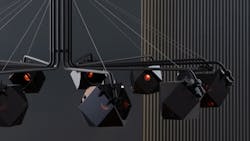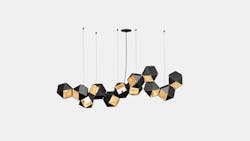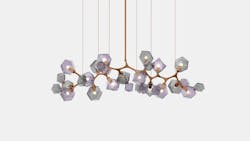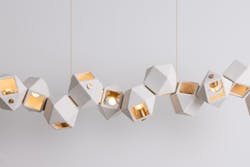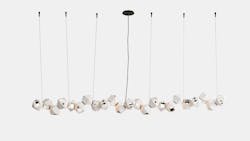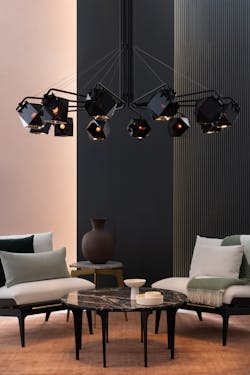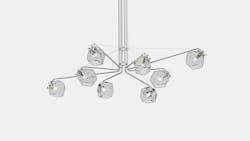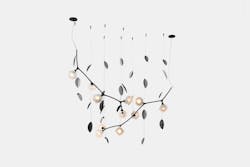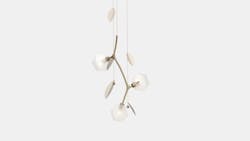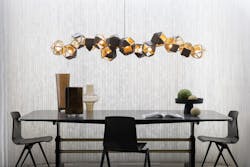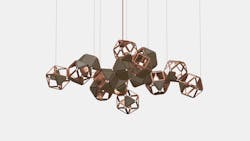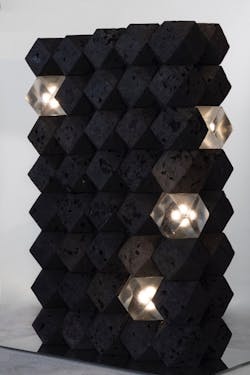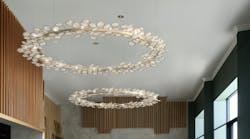In 2012, just as housing prices were finally recovering from the Great Recession, a fashion designer saw market demand for bespoke, contemporary, and modern luminaires and furniture. Scott Richler merged his design experiences in architecture, interiors, furniture, and jewelry to found Gabriel Scott, in Montreal, with the vision of producing a series of handcrafted modular parts in a large enough quantity that they could be combined in custom ways to form collections of products available for distribution worldwide.
A year later, Richler debuted the Welles Chandelier, which has become Gabriel Scott’s most iconic fixture, according to the company. The original Welles chandelier, which went on display at ICFF 2013, combined blackened steel polyhedrons—opened to reveal a brass, copper, or nickel interior finish—in an array of configurations. From the solo polyhedral pendant to sconces, table lamps, and chains with upwards of 30 polyhedrons in unexpected twists and turns, Welles embodied Richler’s vision of customizable, modular design.
Last year, to celebrate its 10th anniversary, the studio reinterpreted the original Welles Chandelier in collaboration with six international architects and interior designers: David Rockwell, Rockwell Group, New York; Kelly Hoppen, Kelly Hoppen Interiors, London; Alessandro Munge, Studio Munge, Toronto; Michelle Gerson, Michelle Gerson Interiors, New York; Sybille de Margerie, Sybille de Margerie, Paris; and Guan Lee, Grymsdyke Farm and Materials Architecture Lab, outside London.
The results of those formative collaborations went on display during Milan Design Week 2022. Last fall, Gabriel Scott announced the formalization of those lighting collaborations into six commercially available capsule collections that together comprise Welles Reimagined. On July 27, the firm announced that the lighting series is a finalist in the lighting category for the 2023 Society of British and International Interior Design Awards.
“The Welles Reimagined capsule collections celebrates our brand ethos,” Richler said in the October 2022 press release. “[T]he collaborations we undertook with each designer perfectly demonstrate how we like to work together with our design and architecture clients to achieve something really special and tailored to their requirements.”
Today, Gabriel Scott has showrooms in New York and London, where Richler is currently based. All the company’s pieces are handmade in a 30,000-square-foot studio in Montreal’s Garment District.
See these six Welles Reimagined capsule collaborations with the studio’s product descriptions below.
David Rockwell
This organic assemblage celebrates the Welles Chandelier’s classic geometric form, while creating a contemporary light fixture inspired by clusters found in nature, such as crystals, chemical compounds, and clouds. The hollowed glass polygons act as metallic light points that come together at varying heights and dimensions to form a floating light cluster. “We experimented with volume, color, texture, and scale to create organic assemblages of light that have a dramatic impact on the atmosphere and our perception of space,” Rockwell said.
Kelly Hoppen
Crafted from white clay, the Kelly Hoppen capsule collection comprises a single flush-mount sconce suitable for both wall and ceiling installation, a pendant light, a single sconce on a banded arm, and the Welles Long Chandelier in three sizes. The overall form has been scaled down to create a more delicate aesthetic. “When I was asked to [collaborate] … instantly I knew I wanted it to be a chalk white, clay, very organic piece, because that would make it incredibly different from anything Gabriel Scott had done before,” Hoppen said.
Alessandro Munge
Infusing dynamic and bold fashion references inspired by rhythmic dance, this collection includes an eight-module chandelier, a 12-module central chandelier, a larger 18-module chandelier, and an arm sconce. The fixture’s modular qualities enable it to extend for extra tall ceilings and multiply for larger spaces.
“[T]he Welles … felt like a sculptural piece of art. So, we drew inspiration from couture fashion, from dance, and when we immersed ourselves in this world, we thought about deconstructing the original piece and rebuilding it in a completely different way,” Munge said.
Michelle Gerson
A floral element represents growth and bloom, alluding to a rebirth of the classic Gabriel Scott design. Gerson’s capsule collection includes a vertical sconce and small, medium, and large versions of a chandelier. “We tried to take a more geometric, modular, masculine type fixture and break it up and create what we thought would be blossoms, branches, and leaves,” Gerson said. “We mixed up the materiality a little by using mesh to create a lightness, we wanted it to feel spacey, alive, and happy.”
Sybille de Margerie
The elegant and smooth capsule collection shows a gradient composition from emptiness to full, with a variation of hollow and plain shapes. It comprises a sconce, cluster sconce, and a standard and smaller chandelier. All fixtures have padded vegan leather to create a subtle 3D effect and rounded corners for softness.
Leather is a “very elegant finish and combined with a soft bronze, this is our vision of luxury, which is very understated,” de Margerie said.
Guan Lee
Illuminating with integrated lamps, this floor installation is made from POLiROCK, a new material developed by Material Architecture Lab. The fired clay, which acts somewhere between ceramic and rock, is made by recycling manufacturing waste. Shown as it appeared in Milan, it will be customized by Lee and the Gabriel Scott design team to deliver something bespoke that fits a client’s expectations, in line with the company’s ethos.
For his Welles Reimagined piece, Lee immediately envisioned a “contrasting material, so instead of something transparent, [I used] something solid that allows light to go through in a very particular way.”
